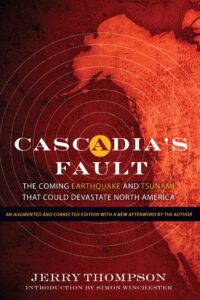Book Review of Cascadia’s Fault

Cascadia’s Fault by Jerry Thompson is perhaps one of the most detailed chronicles of the Pacific Northwest’s geologic history that I have ever seen or read. This comprehensive record starts off through telling the tales of the region’s geologic past, transitions to educating readers on the present, and then concludes by scientifically prophesizing what is to come. The book itself is thorough while still retaining a scientific vocabulary paired to the general reader. This makes Cascadia’s Fault an important and achievable read for nearly anyone. I would personally highly recommend this book to everyone interested in geology and/or history.
Geology has, does, and will play a crucial role in the Pacific Northwest’s identity. The region itself is situated right next to the Cascadia Subduction Zone. Although this fault line isn’t as volatile as others, such as the San Andreas, the earthquakes produced by the Cascadia Subduction Zone are some of the most powerful on Earth. For example, the San Andreas Fault Line has a major earthquake around every 150 years compared to the Cascadia’s once-every-250-years timeline. For sheer magnitude, The San Andreas Fault Line is capable of producing an earthquake with a maximum magnitude of 8.3. On the contrary, the Cascadia Subduction Zone’s earthquakes can clock in at a maximum magnitude of 9.3. Nine times more extreme, the Cascadia Subduction Zone is capable of eclipsing anything produced by the San Andreas fault line.
If that doesn’t seem scary enough, Cascadia’s Fault depicts this story multiple times. The first part of the book covers the region’s geologic past. That includes a plethora of scientific tales regarding major quakes. The last major earthquake to strike the region was in the year 1700. Although European settlers were not yet in the area, the earthquake drastically affected many of the local First Nation tribes inhabiting the Pacific Northwest at the time. Currently, the consequences of a megathrust earthquake in the Pacific Northwest would be far more deadly than previously in 1700.
Around two-thirds of the way through, the book makes a skillful U-turn from scientific nonfiction book to a disaster novel. The last part of Cascadia’s Fault almost feels like a Tom Clancy novel, mathematically depicting every event which would occur during the next major earthquake with upmost detail. This part can be especially suspenseful for those living in the region being talked about.
In my opinion, Cascadia’s Fault by Jerry Thompson is an ingenious book. Not only in the fact that it covers nearly every aspect of the Pacific Northwest’s geologic identity, but that it slices the content down into easily digestible segments comprehendible for the average person. With this book, people living throughout the Pacific Northwest and around the world can learn about the complete geologic history of the region.